Understanding the flea life cycle is the first step making sure fleas will be gone permanently. If you don’t focus on all of the fleas life cycle stages, when treating your home and pets, you will see the problem come back, most likely worse than before.
Fleas can be a real headache for anyone with pets. These tiny pests can multiply rapidly, taking over your home before you know it. Understanding their life cycle is the first step to controlling them. With knowledge of how fleas live and reproduce, you can take targeted actions to get rid of them for good.
Watch The Video Below to Help You Fully Understand The Flea Life Cycle:
The flea life cycle includes four distinct stages: eggs, larvae, pupae, and adults. Each stage has its own characteristics and requires specific conditions to thrive. To effectively control flea infestations, it’s essential to address all stages, not just the adult fleas you can see.
A good grasp of the flea life cycle is crucial because it helps you understand why certain treatments work better than others. Fleas are resilient and can survive in various stages for a long time. Knowing what to expect at each stage allows you to implement a comprehensive strategy that targets every phase of the life cycle.
You’ll also need to use a combination of methods, including cleaning, treating your pets, and possibly seeking professional help. By getting familiar with the life cycle and using the right strategies at the right times, you’ll have a much better chance of winning the battle against fleas.
Understand The Four Stages Of The Flea Life Cycle
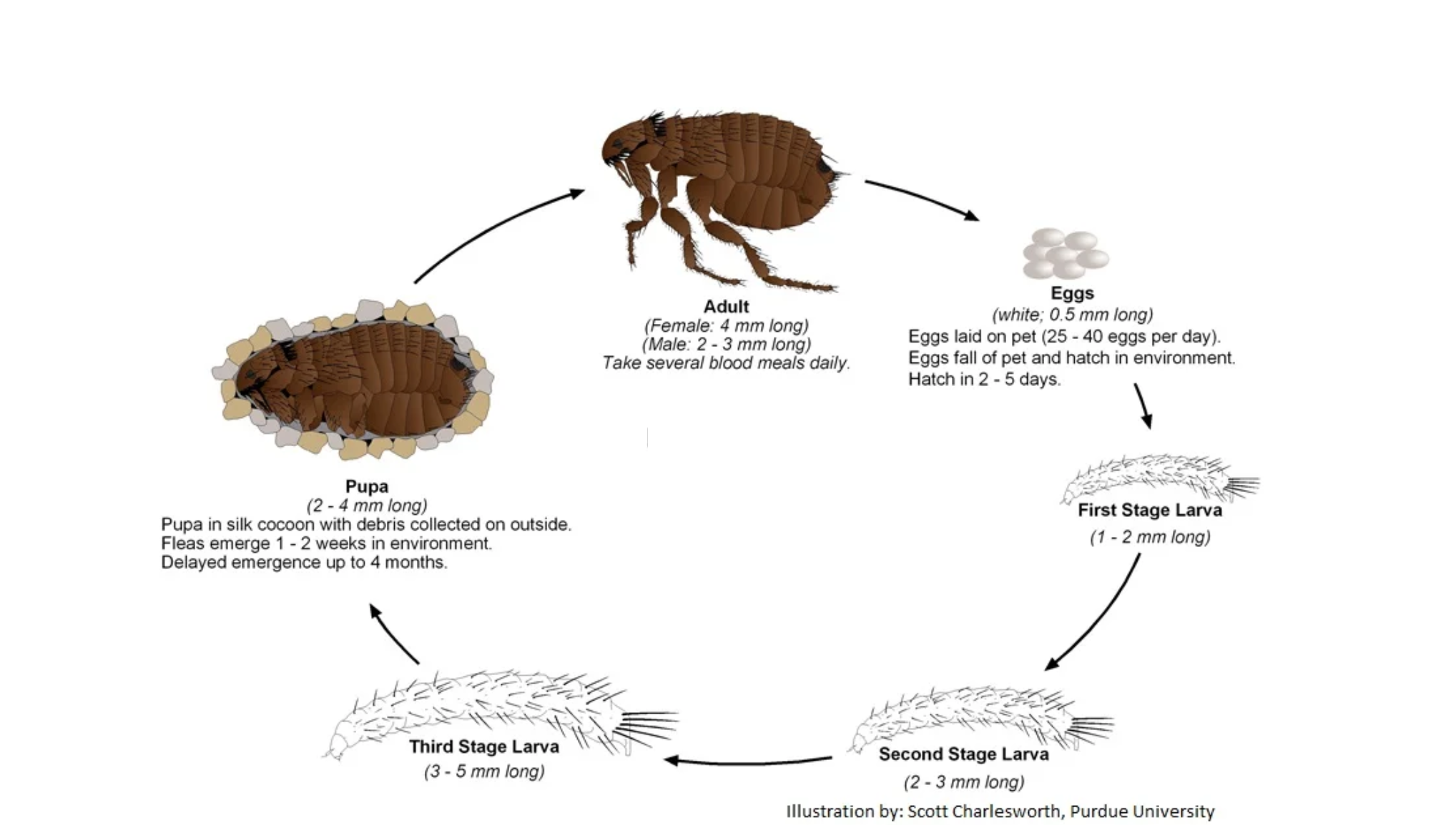
Understanding the flea life cycle means breaking it down into its four key stages: eggs, larvae, pupae, and adults. These stages are quite different from one another, and each requires specific conditions to develop successfully.
The First Stage Of The Flea Life Cycle:
the eggs are laid by adult fleas on the host, often your pet, and then fall off into the environment, such as your pet’s bedding or your carpet. These eggs hatch into larvae within days.
The Second Stage Of The Flea Life Cycle:
the larvae are tiny, worm-like creatures that feed on organic debris and flea dirt. They thrive in dark, humid environments and eventually spin cocoons, transitioning into the pupae stage.
The Third Stage Of The Flea Life Cycle:
the pupae stage is the most challenging to manage. Pupae can remain dormant for weeks or even months, waiting for the right conditions, like vibrations and carbon dioxide from a nearby host, to emerge as adult fleas.
The Fourth Stage Of The Flea Life Cycle:
the adult fleas, once emerged, seek out a host to feed on and start the cycle all over again by laying eggs.
Why Is It Important To Understand The 4 Stages Of The Flea Life Cycle?
Knowing these stages helps you understand why a one-time treatment is rarely effective. To break the flea life cycle, you need a sustained approach that targets fleas at each phase. This includes regular vacuuming, washing pet bedding, and using flea treatments that address both adult fleas and their offspring.
Breaking Down Flea Population Percentages
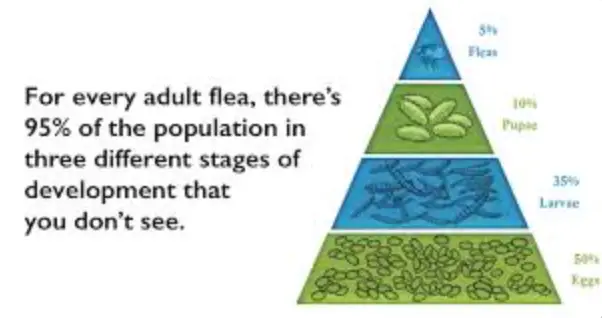
Fleas can seem relentless because their population isn’t just made up of the adults you can see. In fact, about 95% of a flea infestation consists of stages you cannot easily spot. Breaking down the flea population percentages helps to understand where the bulk of the problem lies and how to tackle it effectively.
About 50% of the flea population consists of eggs.
Flea eggs are usually scattered throughout your home, particularly in places where your pets spend a lot of time. These eggs can hatch in a matter of days, setting the stage for a new wave of pests if not addressed. Learn More About The Flea Eggs
About 35% of the flea population consists of flea larvae
These tiny larvae can be tricky to spot as they burrow deep into carpets, furniture, and cracks in the floor. They feed on organic material and flea feces, making these hidden areas prime real estate for them. Learn More About The Flea Larvae
Pupae account for about 10% of the flea population
Understand that this is the most resilient stage. They can stay dormant for long periods, making them difficult to eliminate. Pupae wait for favorable conditions, like the presence of a potential host, before emerging as adult fleas. Learn More About The Flea Pupae
Finally, adult fleas make up only about 5% of the flea cycle population
The adult fleas are the most visible and irritating stage. They live on your pets, feeding on their blood and laying eggs that continue the infestation cycle. Learn More About The Adult Flea
Understanding these population breakdowns highlights the importance of treating your home thoroughly and consistently. It’s not enough to treat only the adult fleas on your pet. You must also tackle the hidden eggs, larvae, and pupae lurking in your home. Combining pet treatments with rigorous cleaning routines ensures a more comprehensive approach to flea control.
What Is the Flea Egg Stage Of The Flea Life Cycle?

Flea eggs are the first step in the flea life cycle. They are tiny, almost microscopic, and can be hard to see with the naked eye. These white, oval-shaped eggs are usually laid on your pet by adult fleas after they’ve had a blood meal. However, these eggs don’t stay on the pet for long—they fall off into the environment, like your pet’s bedding, your carpet, or anywhere your pet spends time.
Once in the environment, flea eggs hatch within two to twelve days, depending on the conditions. The higher the humidity and temperature, the faster they hatch. This is why infestations can often spike during warmer months or if there’s a sudden increase in indoor humidity.
Flea eggs are resilient to many forms of treatment, so simply vacuuming or washing your pet isn’t enough. To tackle flea eggs effectively, consider using an insect growth regulator (IGR). These chemicals interrupt the development of eggs and larvae, ensuring they don’t progress to the next stage.
Preventive measures are also vital in controlling flea eggs. Regularly washing your pet’s bedding in hot water, frequent vacuuming, and treating areas where your pet spends a lot of time can help reduce the number of eggs in your home. By targeting flea eggs specifically, you contribute significantly to breaking the flea life cycle at its root.
What Is the Flea Larvae Stage Of The Flea Life Cycle?
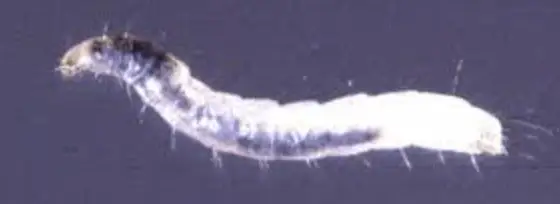
The flea larvae stage follows the egg stage. These larvae emerge from the eggs and are small, worm-like creatures, measuring about 2-5mm in length. Unlike adult fleas, larvae are blind and avoid light, preferring dark, secluded areas like deep in your carpet fibers, under furniture, or in cracks in the floor.
Flea larvae feed on organic matter, including flea dirt (the partially digested blood excreted by adult fleas), dead skin, and other debris. This feeding phase lasts anywhere from 5 to 20 days, depending on environmental conditions such as humidity and temperature. In the right conditions, larvae grow quickly; in less favorable conditions, their development can slow down significantly.
Targeting flea larvae requires a thorough cleaning regime. Regularly vacuuming carpets, rugs, and furniture where your pets spend most of their time helps to remove larvae and their food sources. Disposing of vacuum bags immediately is crucial to preventing re-infestation.
Supplement cleaning efforts with specific flea treatments designed to target larvae. Insect growth regulators (IGRs) are particularly effective because they disrupt the larvae’s development, preventing them from reaching the pupae stage. Ensuring proper ventilation and reducing humidity can also make the environment less hospitable for larvae, further helping in their control.
What Is the Flea Pupae Stage Of The Flea Life Cycle?
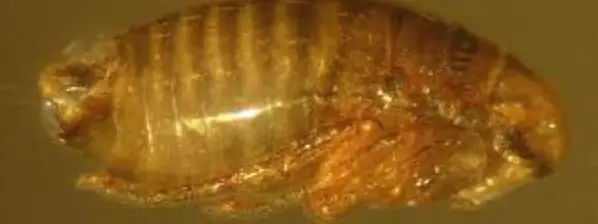
The flea pupae stage is often considered the most challenging phase to control in the flea life cycle. After spending some time as larvae, fleas form cocoons around themselves, transitioning into pupae. These cocoons are sticky and can easily hide in your carpet, furniture, or pet bedding.
Flea pupae are particularly resilient. They can remain dormant for weeks, sometimes even months, waiting for the right conditions to transform into adult fleas. Stimuli such as vibrations, carbon dioxide, and heat from potential hosts trigger the emergence of adult fleas. This delayed emergence can make it seem like the infestation is under control when it isn’t.
Addressing the pupae stage requires a mix of patience and strategic action. Regular vacuuming can help disturb the pupae, while steam cleaning carpets and upholstery can kill them by exposing them to high temperatures. Unfortunately, typical flea sprays are less effective against flea pupae because their protective cocoons shield them from chemicals.
Maintaining a clean environment and using integrated pest management strategies, like insect growth regulators in combination with adulticides, helps reduce the number of emerging adult fleas. Remember that controlling flea pupae is a long-term commitment and requires consistency.
What Is the Adult Flea Stage Of The Flea Life Cycle?
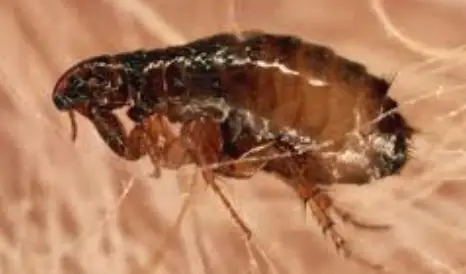
The adult flea stage is the most visible and bothersome phase of the flea life cycle. Adult fleas are about 1-3mm long, reddish-brown, and have flat bodies that allow them to move easily through fur and feathers. Their primary goal is to find a host, usually your pet, feed on blood, and reproduce rapidly.
Adult fleas are equipped with strong back legs that make them excellent jumpers, allowing them to transfer from host to host or from the environment onto a host. As soon as they find a host, they begin feeding within minutes and can start laying eggs within 24-48 hours, thus perpetuating the infestation.
Controlling adult fleas starts with treating your pets. Veterinary-recommended flea treatments, such as topical treatments, oral medications, and flea collars, are very effective in killing adult fleas and preventing new ones from settling on your pet.
However, treating your pet is just part of the solution. You’ll also need to address the environment. Regular vacuuming, washing pet bedding in hot water, and using flea sprays in your home are necessary to reduce the overall flea population. Keep an eye out for flea dirt (tiny black specks) in your pet’s fur, as this is a sign that fleas are active.
Consistency is key. Continuous monitoring of your pet and living environment ensures that you catch any new fleas early, preventing them from laying eggs and breaking the life cycle. Combining these efforts creates a comprehensive approach to effectively manage and eradicate adult fleas.
Effective Strategies to Break the Flea Life Cycle
Breaking the flea life cycle requires a multi-faceted approach, targeting every stage from eggs to adult fleas. A well-rounded strategy combines regular cleaning with appropriate treatments and preventive measures.
Start with your pet, as they are the primary host for adult fleas. Use vet-recommended flea treatments like topical solutions, oral medications, or flea collars. These treatments kill adult fleas and can also help prevent new ones from settling on your pet. Frequent grooming with a fine-tooth flea comb can also help catch and remove fleas.
For your home, consistent vacuuming is crucial. Focus on areas where your pets spend most of their time, like carpets, rugs, furniture, and pet bedding. Dispose of vacuum bags immediately to prevent re-infestation. Washing pet bedding and any other washable items in hot water can help kill fleas, larvae, and eggs.
Consider using Insect Growth Regulators (IGRs). These chemicals prevent flea eggs and larvae from maturing into adults, tackling the infestation at its root. Combining IGRs with adulticides, which kill adult fleas, can provide a more effective treatment regime.
Environmental control is equally important. Fleas thrive in warm, humid conditions, so controlling the indoor climate can make your home less hospitable to them. Dehumidifiers and air conditioning can help reduce moisture levels, making it harder for fleas to develop. Additionally, steam cleaning carpets and rugs can kill fleas in all stages of their life cycle.
Persistence and consistency are vital. It can take several weeks or even months to completely break the flea life cycle. Regularly monitor your pets and home for signs of fleas, continuing treatments as necessary. The effort pays off in the long run, leading to a flea-free living environment for you and your pets.
By staying vigilant and using a combination of these strategies, you can effectively break the flea life cycle. This comprehensive approach ensures that you address not just the visible fleas, but also the hidden eggs, larvae, and pupae, giving you the upper hand in this ongoing battle.
Find Step by Step Instructions to Get Rid of Fleas by Following These Links:
In Conclusion Of The Flea Life Cycle & How To Break It
The flea life cycle is not impossible to break, but it does take time to do it effectively. It will probably seem extremely overwhelming to many when they first realize the steps to take.
Yes, you could just flea bomb your home or apartment and treat your pets, if you have them, to kill the fleas. However, fleas can hide in all the nooks and crannies of floors, furniture and carpets.
If you don’t take the steps to treat all areas of your home, yard and pets efficiently, there is a high probability of them coming back to haunt you.
I hope you now have a better understanding of the flea life cycle, and how to break it. If you have tried other things that have worked, please share them below in the comments section, with everyone.
If you have any questions about the flea life cycle or any of the steps to get rid of the fleas, please leave them below in the comments section as well.
Thank you for visiting Fleas B Gone, have a great day 🙂


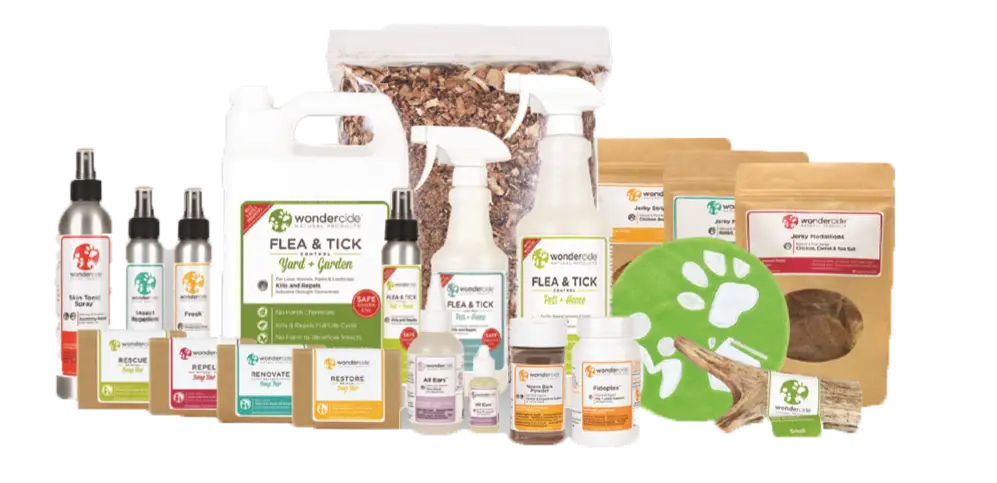



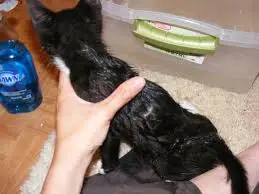


I have a dog and this will be helpful if she ever gets fleas!
I am very glad that this could be helpful for you!